This 1960 Chrysler convertible puts me in a New Yorker state of mind

I’ve always had a huge interest in vintage American luxury cars: Cadillac, Lincoln, Mercury, Imperial, Chrysler, Oldsmobile, and Buick. As a kid, watching 1980s TV, I always wanted the black Cadillacs, Town Cars, and Fifth Avenues the bad guys drove, not Magnum’s 308GTB or Michael Knight’s talking Trans Am. You can probably blame that one on my grandparents; my Grandma Ruby’s 1977 Thunderbird and Grandpa Bob’s navy blue 1977 Continental Mark V saw to it. From my earliest memories, I was into cars and had umpteen Matchboxes, Hot Wheels, and Corgi toys to prove it.

One of the earliest memories I have of car shows was when my mom and dad took me to the June Jamboree, a car show and festival in town back in about 1986. I would have been in first grade at the time. The only car I have strong memories of was a gigantic black 1955 Cadillac Fleetwood 60 Special. This was an imposing motor car, by any standard. Even more imposing when one is only four feet tall.
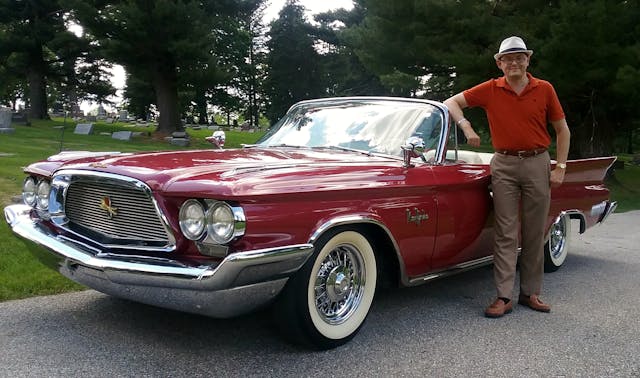
Fast forward 35-odd years and I still love vintage domestic lux rolling stock. And with all my car buddies near and far, I never know what I’ll get to check out next. Case in point: K V Dahl, a friend of mine who just happens to also be the local Ford dealer, got a blue 1962 Continental convertible a few years back. I’ve wanted to write it up (and get a ride in it too—yes, ulterior motives, and all that), and though I had some pictures of it, I wanted to get some beauty shots of the car sitting outside. K V said we could definitely do that. So back in the spring of 2017, I called him up and said, “Hey, I’d like to get some shots of the Continental sometime this week if you’re around.” To which he responded, “Well sure, but you should see what I got this week in Indianapolis!” “What?” “It’s a 1960 Chrysler New Yorker convertible. It’s sitting out front of the dealership right now. Want to stop by?” (… long pause …) “I’m on the way!”
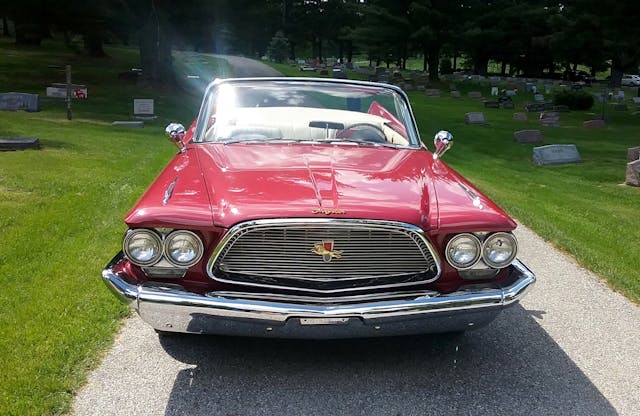
The 1960 Chryslers were all-new, and the second generation of Virgil Exner’s Forward Look was extremely attractive. And fins? Oh, heck yes! Despite all the glamour and glitz that was de rigueur back then, the biggest news was under the skin, where all Mopars (save Imperial) went to unit-body construction.
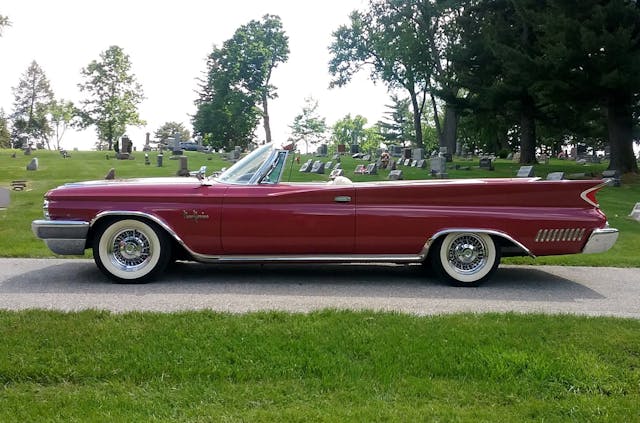
The 1960 Chrysler lineup was homogeneous yet diverse at the same time. There were no mid-size cars, no compacts, subcompacts, SUVs, nor crossovers. Everything was a variation on a theme— said theme being an unapologetically full-size Chrysler motor car with unmistakable, giant fins. But there was a wide variety of body styles and trim levels. And colors! Oh, the colors! And hardtops! And wagons! And push-button Torque-Flite transmissions! And chrome, chrome, chrome!

Sure, if you didn’t want to drive such a gunboat, you were kind of out of luck, but that’s what Renault Dauphines and VWs were for. And you could admire the Chryslers and then check out the new compact Valiant sharing the showroom if you were more interested in smaller cars.
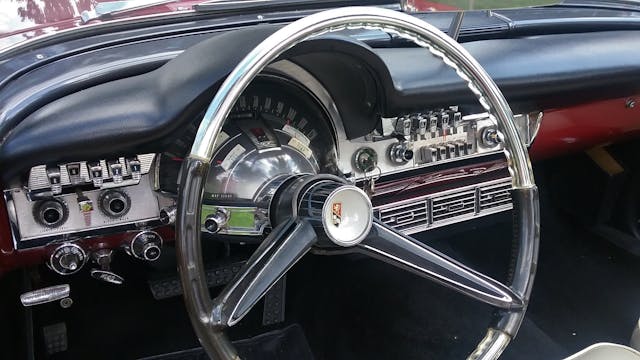
The other big deal on ’60 Chryslers was the most excellent Astra-Dome instrument cluster. In addition to its cool looks, the Astra Dome instrumentation introduced electroluminescent lighting to Chryslers for the first time. Instead of small bulbs throwing light upon the surface of the gauges (think spotlights on a stage), the numbers and needles were illuminated from within, in bright green and red. Not only did they look cool, they reduced glare compared to the more commonly illuminated gauges on other 1960 model year cars.

One interesting factoid on 1960–62 Chryslers. The rare buyer who wanted a manual transmission would have received a floor-mounted gearshift instead of the three-on-the-tree column shift. With the Astra Dome extending all the way to the steering wheel, there simply wasn’t any place to put it!

Super cool, but as you might expect, they were rather expensive to make, especially in 1960. But back then Chrysler was still the engineering-focused member of the Big Three, despite the early-rusting and troublesome 1957 Forward Look cars. Only 1960–62 Chryslers and 1960–63 Imperials got the EL gauge clusters. They looked pretty good in the top-tier Imperials too.
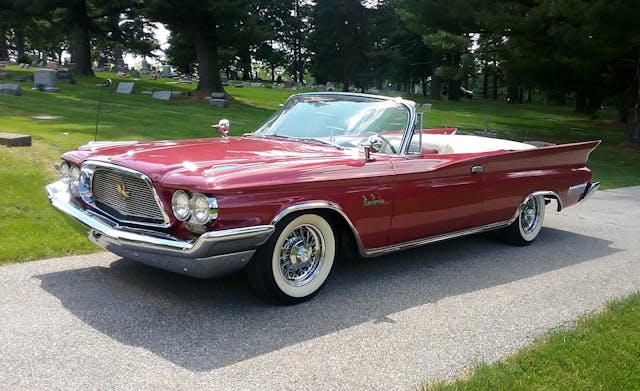
They were an indicator (no pun intended) of the future, as all cars eventually went this route, with the numbers and needles lit from within on pretty much everything by the late 1970s and early ’80s. In this picture you can see another gee-whiz late-1950s/early-60s Chrysler gadget, the swing out seats. Designed to help (in theory) people get in and out of the rather low 1957–62 Chryslers, they were an option, and depending on whether it was a Dodge or Chrysler or whatever, they automatically swung out or were operated via a lever on the seat.

As usual, the New Yorker was the top of the line, and while not quite in the same league as a Cadillac, Lincoln, or Imperial, it was nevertheless a swank set of wheels. Lots of Jet Age details abound; even the interior door handles have a jet thruster look to them.

K V’s new addition to the collection has a bit of history too. It was the cover car for the December 1994 issue of Collectible Automobile, which ran a feature story on the 1960–62 Chryslers. Of course, K V has a copy of the magazine in the car … and was nice enough to make a color copy of the article for me.

At any rate, I arrived at Dahl Ford in due course and met up with K V. As we exited the side door of the dealership, I spotted the New Yorker in a primo parking place and fired up the camera, but K V said the car deserved better pictures than sitting in a parking lot. “Let’s take it for a ride!” Um, hell yes, OK! I’m in!
A nearby cemetery provided a good background for pictures. I can also tell you that this is one smooth riding car. You think the late-model Town Cars and Cadillac DTSs ride nice? These mid-century yachts blow them totally out of the water!

You don’t really drive, you kind of float. But with that famous Chrysler Corporation Torsion-Aire suspension, it handles pretty darn fair for such a big car.
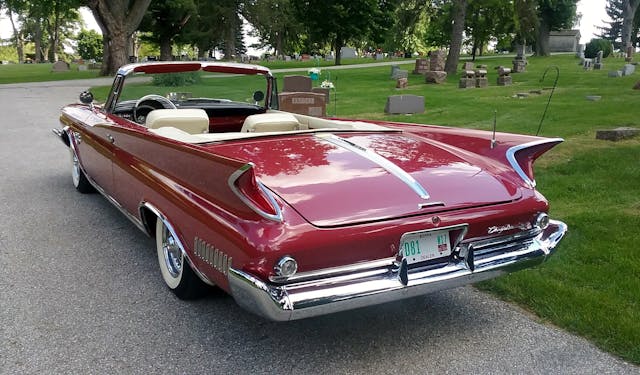
But as good as the entire car looks, let’s face it, it’s all about the fins. The 1960 Chrysler is, in my opinion, one of the best-looking Mopars of the late ’50s and early ’60s. I like it even more than the ’57 “Suddenly it’s 1960” Chryslers, which are pretty damn attractive in their own right. The ’60 is just so smooth—the whole car, from nose to tail, is smooth and flowing.

Sadly, that terrific look was slightly marred a bit in the ’61 restyle. The slanting quad headlamps just aren’t as attractive. It’s like they just changed it for the sake of change, and while that was the rule of the day in Detroit at the time, I kind of wish they’d just done a new grille insert and side trim instead of this. I like them, don’t get me wrong, but not as much as I like the 1960 Chryslers.
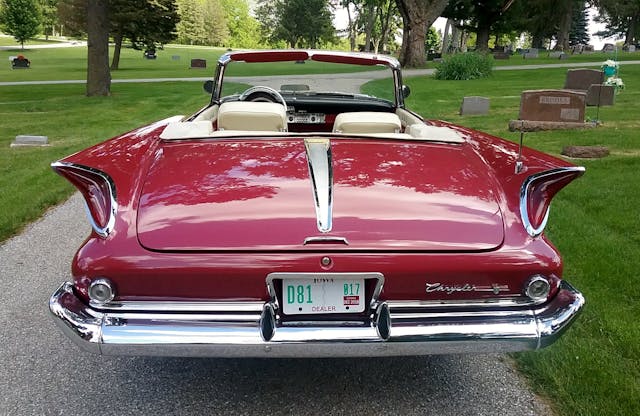
If you ever happen to see a 1960 New Yorker in person, you’re in rare company. For whatever reason, drop-top Mopars didn’t sell back then, while over at GM Cadillac convertibles were flying off the assembly lines. Total sales of topless New Yorkers that year were a mere 556 units. I kid you not. Each retailed for $4875 $48,883 today) before options. For those wanting Forward Look fins in a less-costly version could have gotten a Windsor for $3623 $36,329). Windsor convertible production was 1467 for the year, better than the New Yorker but still minuscule.
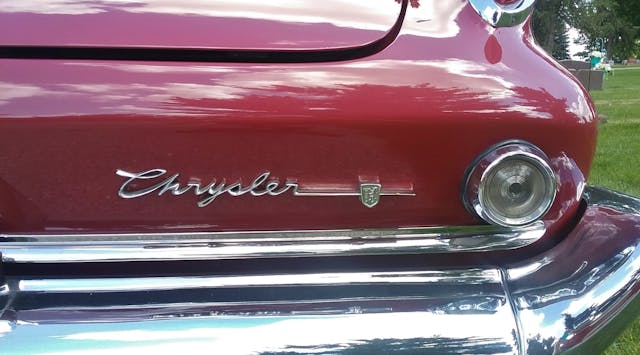
And for those for which cost was no object, the 300F was available for $5841 ($58,569). It was even rarer than the New Yorker, with 248 being sold. But it was so cool!

And that, ladies and gentlemen, is how a 1962 Continental article turned into a 1960 Chrysler love fest. But never fear, the Lincoln will get written about one of these days. Until then, keep calm and Brougham on!


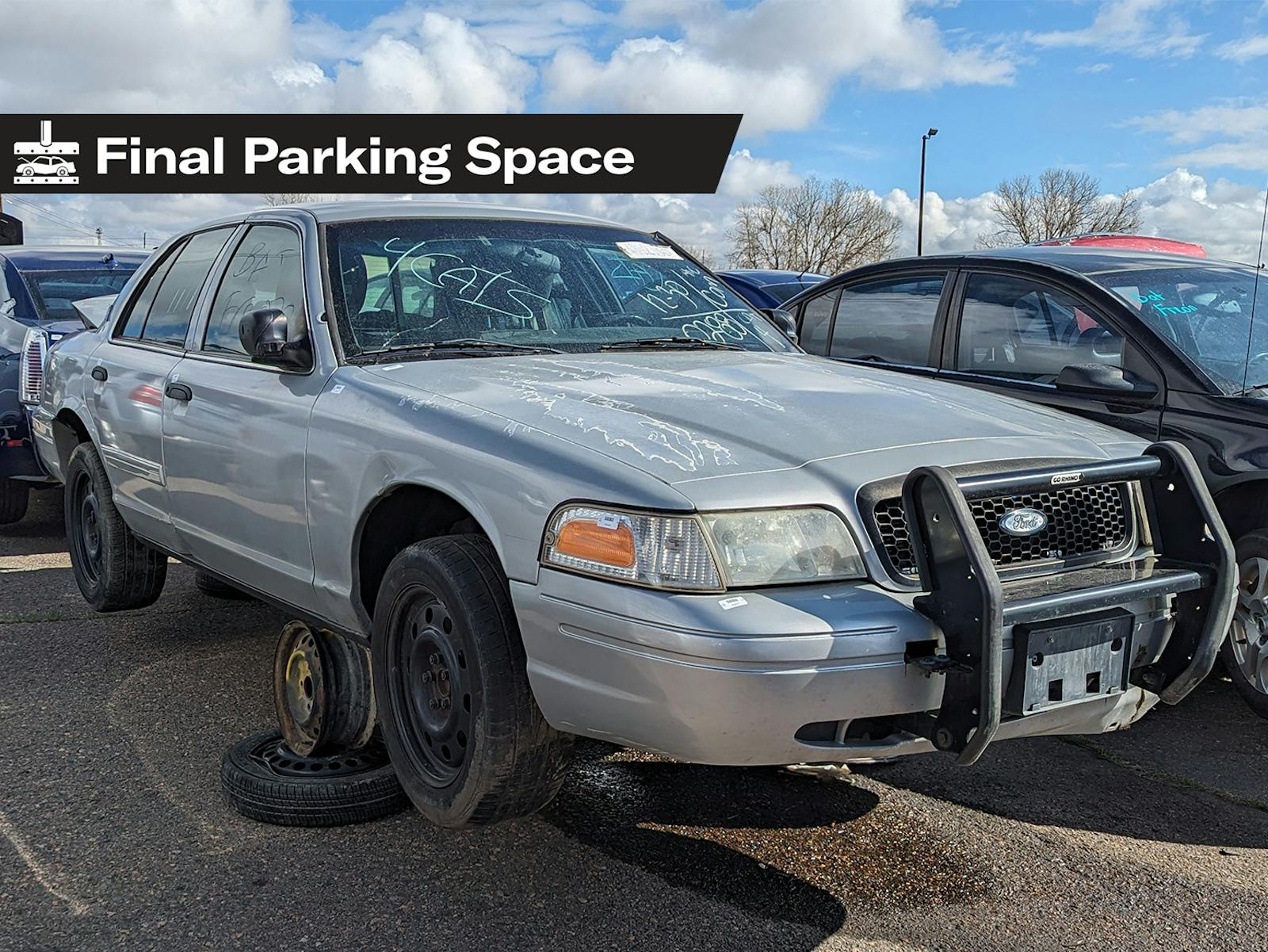
Yep. This gives me a raging b**er! Just gorgeous!
In 1987 I picked up a 300F hardtop (from a salvage yard!). $1200. Straight, if a bit rusty, but it ran and drove just fine. The 300F included a console that ran full length between those bucket seats and split the rear bench. 2+2 seating. There was a mechanical tachometer mounted in that console; that and the 150 mph speedometer are now worth than twice what I paid for the whole car! Mine also included the “toilet seat” trunklid….
The real treat was under the hood: 413 Cross Ram! Located over each exhaust manifold was a Carter 4-barrel carburetor, mounted on a long ram manifold feeding the cylinder bank on the opposite side of the engine. Mash the go pedal, and that beast had no trouble keeping up with, and, yes, humbling many a ’60s muscle car.
The author failed to mention that the turn signal lever was dash mounted. Since the transmission was operated by push-buttons, the steering column was free of any protuberances. The manual transmission-equipped cars required a floor shifter because there wasn’t enough room for a column-mounted shifter? I suspect it had more to do with the designers not wishing to clutter-up their clean steering column….
I’ve had a 60 New Yorker 4 door hardtop for many years. I never get tired of going out in the garage and looking at it.
The car pictured has wire wheels, which were not a factory option in 1960. They look bigger than the 14 in wheels the car came with. Mine now has 15 in wheels. I did a brake swap years back so it has 4 wheel discs. This made driving it a lot more pleasant.
I also have the optional trunk lid with the imitation tire. I can’t decide which trunk lid to use, so I painted both, and occasionally swap them out. The chrome molding in the middle of the lid is a New Yorker only part.
The electroluminescnet dash lighting requires high voltage alternating current. There is a box under the dash that hums softly when the lights are on. For the 3 years of thi setup, they had a new box for every year, each one smaller.
Chrysler didn’t offer a manual transmission in 60, except in the 300F. That was a French transmission, and used a shifter in the console. In 61, Chrysler offered a bargain basement Newport with a manual. It used the floor shifter from the Valiant. The base Newport even came with manual steering and manual brakes.
What a nice car!
“They were an indicator (no pun intended) of the future, as all cars eventually went this route, with the numbers and needles lit from within on pretty much everything by the late 1970s and early ’80s. ”
Actually, backlit instrumentation was introduced to the industry by; you guessed it… Chrysler. This time in 1974, and this time with conventional incandescent bulbs. But they were now diffused and of uniform brightness. No hotspots or glare. The first car line to use them were the freshly re-designed C-bodies, everthing from Plymouth Fury to Imperial. Eventually it spread to other models and makes.
Great appreciation of those Fantastic fined Chryslers. The features you pointed out were exactly what I like about those Chryslers. The 1960 Chryslers didn’t just have fins, they had a gorgeous flair to them. The shape of the taillights is so cool. I would love to know how the design engineers came up with such creative ideas that are so exciting. I love American cars from the late 50s and early 60s as you do. You mentioned the Astrodome with Panelesent lighting as Chrysler called it. The bluish green glow they created was just mesmerizing. I was only 5 years old in 1960, I had 2 uncles that had a 61, and 62 Chryslers, the 61 was a white 2 door Newport with blue interior and the other was a 62 carmal colored 300. They both had the Astrodome instrument panels. The 62s lost their fins, but the taillights were kinda weird looking, but I love their weird looks, I remember just staring at them. They had great character. They are actually kind of difficult to describe, but I found them very attractive. To me the forward look was so unique, you could see why they may have not been for everyone, but I love them. In any event, thanks for your post, I really enjoyed and appreciated it.